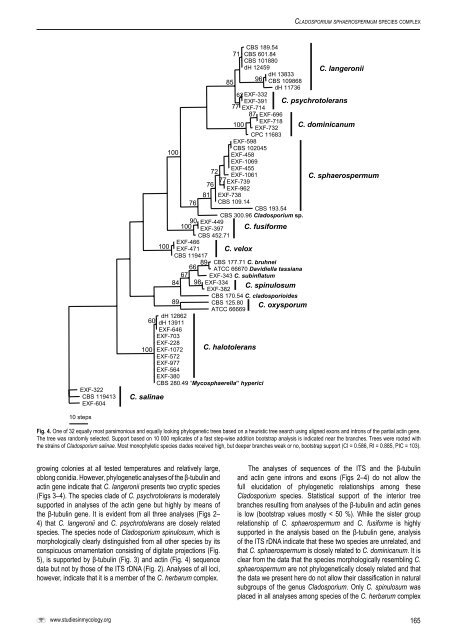The genus Cladosporium and similar dematiaceous ... - CBS - KNAW
The genus Cladosporium and similar dematiaceous ... - CBS - KNAW
The genus Cladosporium and similar dematiaceous ... - CBS - KNAW
Create successful ePaper yourself
Turn your PDF publications into a flip-book with our unique Google optimized e-Paper software.
<strong>Cladosporium</strong> sphaerospermum species complex<br />
EXF-322<br />
<strong>CBS</strong> 119413<br />
EXF-604<br />
60<br />
100<br />
C. salinae<br />
<strong>CBS</strong> 189.54<br />
71 <strong>CBS</strong> 601.84<br />
<strong>CBS</strong> 101880<br />
dH 12459<br />
dH 13833<br />
96 <strong>CBS</strong> 109868<br />
dH 11736<br />
62 EXF-332<br />
EXF-391<br />
77 EXF-714<br />
<strong>CBS</strong> 177.71 C. bruhnei<br />
66 89 ATCC 66670 Davidiella tassiana<br />
67 EXF-343 C. subinflatum<br />
85<br />
C. psychrotolerans<br />
87 EXF-696<br />
EXF-718<br />
100<br />
EXF-732<br />
C. dominicanum<br />
CPC 11683<br />
EXF-598<br />
100<br />
<strong>CBS</strong> 102045<br />
EXF-458<br />
EXF-1069<br />
EXF-455<br />
72<br />
EXF-1061<br />
77EXF-739<br />
76<br />
EXF-962<br />
C. sphaerospermum<br />
81 EXF-738<br />
76 <strong>CBS</strong> 109.14<br />
<strong>CBS</strong> 193.54<br />
<strong>CBS</strong> 300.96 <strong>Cladosporium</strong> sp.<br />
EXF-449<br />
100 90<br />
EXF-397 C. fusiforme<br />
<strong>CBS</strong> 452.71<br />
100<br />
EXF-466<br />
EXF-471<br />
<strong>CBS</strong> 119417<br />
C. velox<br />
84 98 EXF-334<br />
EXF-382<br />
C. spinulosum<br />
<strong>CBS</strong> 170.54 C. cladosporioides<br />
89<br />
<strong>CBS</strong> 125.80<br />
ATCC 66669<br />
C. oxysporum<br />
dH 12862<br />
dH 13911<br />
EXF-646<br />
EXF-703<br />
EXF-228<br />
EXF-1072 C. halotolerans<br />
EXF-572<br />
EXF-977<br />
EXF-564<br />
EXF-380<br />
<strong>CBS</strong> 280.49 “Mycosphaerella” hyperici<br />
C. langeronii<br />
10 steps<br />
Fig. 4. One of 32 equally most parsimonious <strong>and</strong> equally looking phylogenetic trees based on a heuristic tree search using aligned exons <strong>and</strong> introns of the partial actin gene.<br />
<strong>The</strong> tree was r<strong>and</strong>omly selected. Support based on 10 000 replicates of a fast step-wise addition bootstrap analysis is indicated near the branches. Trees were rooted with<br />
the strains of <strong>Cladosporium</strong> salinae. Most monophyletic species clades received high, but deeper branches weak or no, bootstrap support (CI = 0.586, RI = 0.885, PIC = 103).<br />
growing colonies at all tested temperatures <strong>and</strong> relatively large,<br />
oblong conidia. However, phylogenetic analyses of the β-tubulin <strong>and</strong><br />
actin gene indicate that C. langeronii presents two cryptic species<br />
(Figs 3–4). <strong>The</strong> species clade of C. psychrotolerans is moderately<br />
supported in analyses of the actin gene but highly by means of<br />
the β-tubulin gene. It is evident from all three analyses (Figs 2–<br />
4) that C. langeronii <strong>and</strong> C. psychrotolerans are closely related<br />
species. <strong>The</strong> species node of <strong>Cladosporium</strong> spinulosum, which is<br />
morphologically clearly distinguished from all other species by its<br />
conspicuous ornamentation consisting of digitate projections (Fig.<br />
5), is supported by β-tubulin (Fig. 3) <strong>and</strong> actin (Fig. 4) sequence<br />
data but not by those of the ITS rDNA (Fig. 2). Analyses of all loci,<br />
however, indicate that it is a member of the C. herbarum complex.<br />
<strong>The</strong> analyses of sequences of the ITS <strong>and</strong> the β-tubulin<br />
<strong>and</strong> actin gene introns <strong>and</strong> exons (Figs 2–4) do not allow the<br />
full elucidation of phylogenetic relationships among these<br />
<strong>Cladosporium</strong> species. Statistical support of the interior tree<br />
branches resulting from analyses of the β-tubulin <strong>and</strong> actin genes<br />
is low (bootstrap values mostly < 50 %). While the sister group<br />
relationship of C. sphaerospermum <strong>and</strong> C. fusiforme is highly<br />
supported in the analysis based on the β-tubulin gene, analysis<br />
of the ITS rDNA indicate that these two species are unrelated, <strong>and</strong><br />
that C. sphaerospermum is closely related to C. dominicanum. It is<br />
clear from the data that the species morphologically resembling C.<br />
sphaerospermum are not phylogenetically closely related <strong>and</strong> that<br />
the data we present here do not allow their classification in natural<br />
subgroups of the <strong>genus</strong> <strong>Cladosporium</strong>. Only C. spinulosum was<br />
placed in all analyses among species of the C. herbarum complex<br />
www.studiesinmycology.org<br />
165

















